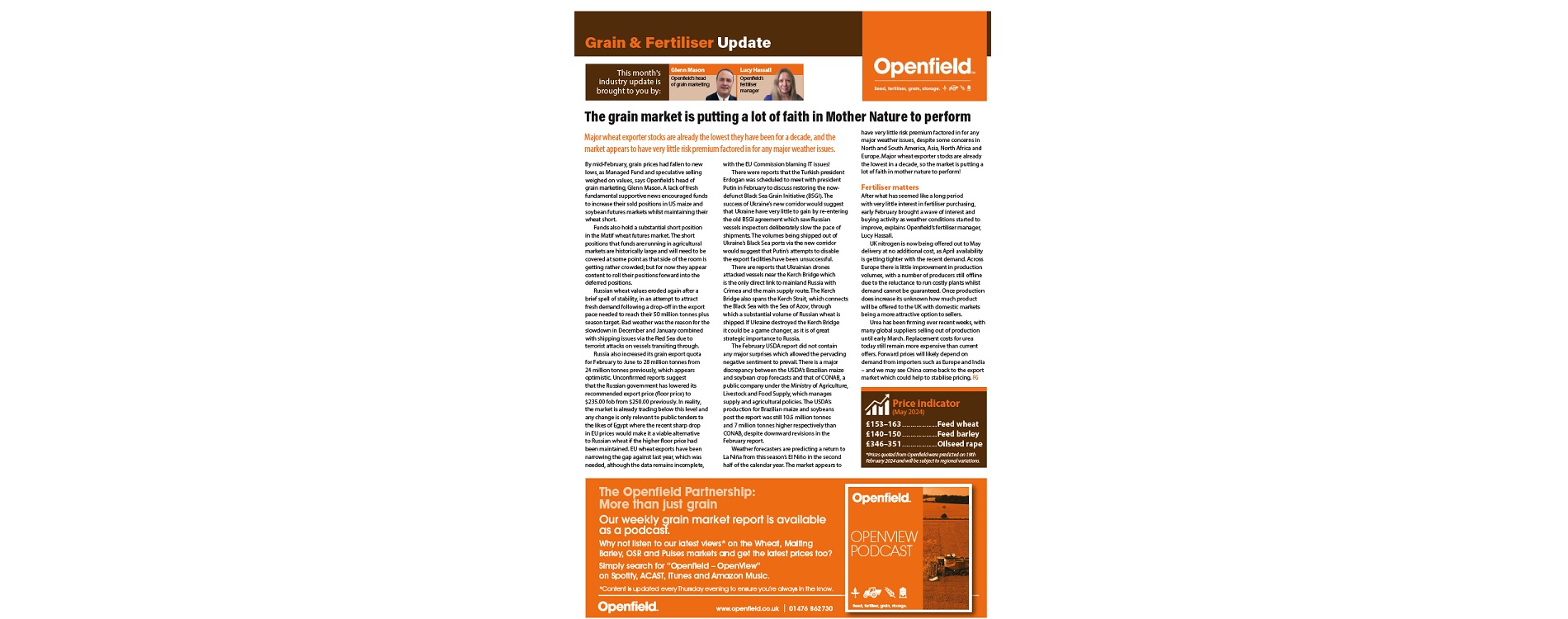The grain market is putting a lot of faith in Mother Nature to perform
Major wheat exporter stocks are already the lowest they have been for a decade, and the market appears to have very little risk premium factored in for any major weather issues.
By mid-February, grain prices had fallen to new lows, as Managed Fund and speculative selling weighed on values, says Openfield’s head of grain marketing, Glenn Mason. A lack of fresh fundamental supportive news encouraged funds to increase their sold positions in US maize and soybean futures markets whilst maintaining their wheat short. Funds also hold a substantial short position in the Matif wheat futures market. The short positions that funds are running in agricultural markets are historically large and will need to be covered at some point as that side of the room is getting rather crowded; but for now they appear content to roll their positions forward into the deferred positions.
Russian wheat values eroded again after a brief spell of stability, in an attempt to attract fresh demand following a drop-off in the export pace needed to reach their 50 million tonnes plus season target. Bad weather was the reason for the slowdown in December and January combined with shipping issues via the Red Sea due to terrorist attacks on vessels transiting through. Russia also increased its grain export quota for February to June to 28 million tonnes from 24 million tonnes previously, which appears optimistic. Unconfirmed reports suggest that the Russian government has lowered its recommended export price (floor price) to $235.00 fob from $250.00 previously. In reality, the market is already trading below this level and any change is only relevant to public tenders to the likes of Egypt where the recent sharp drop in EU prices would make it a viable alternative to Russian wheat if the higher floor price had been maintained. EU wheat exports have been narrowing the gap against last year, which was needed, although the data remains incomplete, with the EU Commission blaming IT issues!
There were reports that the Turkish president Erdogan was scheduled to meet with president Putin in February to discuss restoring the now defunct Black Sea Grain Initiative (BSGI). The success of Ukraine’s new corridor would suggest that Ukraine have very little to gain by re-entering the old BSGI agreement which saw Russian vessels inspectors deliberately slow the pace of shipments. The volumes being shipped out of Ukraine’s Black Sea ports via the new corridor would suggest that Putin’s attempts to disable the export facilities have been unsuccessful. There are reports that Ukrainian drones attacked vessels near the Kerch Bridge which is the only direct link to mainland Russia with Crimea and the main supply route. The Kerch Bridge also spans the Kerch Strait, which connects the Black Sea with the Sea of Azov, through which a substantial volume of Russian wheat is shipped. If Ukraine destroyed the Kerch Bridge it could be a game changer, as it is of great strategic importance to Russia.
The February USDA report did not contain any major surprises which allowed the pervading negative sentiment to prevail. There is a major discrepancy between the USDA’s Brazilian maize
and soybean crop forecasts and that of CONAB, a public company under the Ministry of Agriculture, Livestock and Food Supply, which manages
supply and agricultural policies. The USDA’s production for Brazilian maize and soybeans post the report was still 10.5 million tonnes and 7 million tonnes higher respectively than
CONAB, despite downward revisions in the February report.
Weather forecasters are predicting a return to La Niña from this season’s El Niño in the second half of the calendar year. The market appears to have very little risk premium factored in for any
major weather issues, despite some concerns in North and South America, Asia, North Africa and Europe. Major wheat exporter stocks are already the lowest in a decade, so the market is putting a
lot of faith in mother nature to perform!
Fertiliser matters
After what has seemed like a long period with very little interest in fertiliser purchasing, early February brought a wave of interest and buying activity as weather conditions started to improve, explains Openfield’s fertiliser manager, Lucy Hassall. UK nitrogen is now being offered out to May delivery at no additional cost, as April availability is getting tighter with the recent demand.
Across Europe there is little improvement in production volumes, with a number of producers still offline due to the reluctance to run costly plants whilst demand cannot be guaranteed. Once production does increase its unknown how much product will be offered to the UK with domestic markets being a more attractive option to sellers. Urea has been firming over recent weeks, with
many global suppliers selling out of production until early March. Replacement costs for urea today still remain more expensive than current offers. Forward prices will likely depend on demand from importers such as Europe and India – and we may see China come back to the export market which could help to stabilise pricing.




